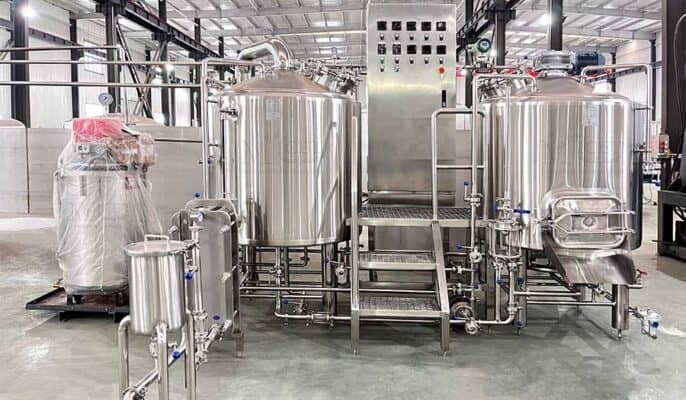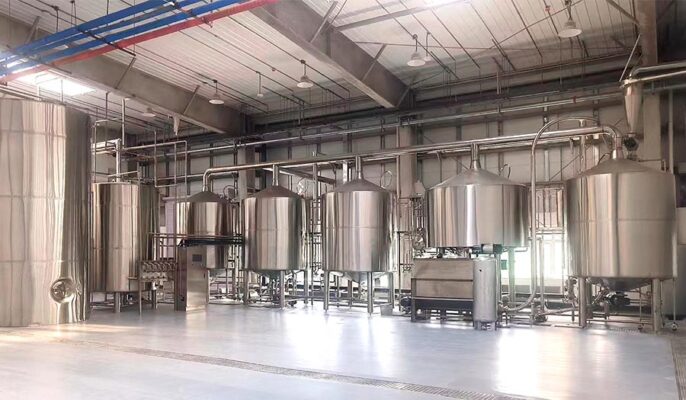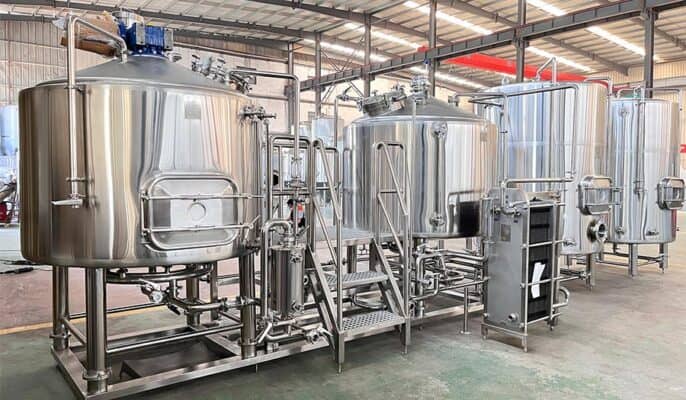Brewhouse equipment refers to the components and systems used to produce beer through the brewing process. Selecting the right brewhouse setup is crucial for craft breweries to achieve their production goals and make great tasting beers consistently. This guide provides a comprehensive overview of the various types of brewhouse systems, design considerations, sizing guidelines, cost implications, and tips for choosing the ideal configuration for your needs.
Types of Brewhouse Systems
There are several main types of brewhouse configurations to choose from:
| Brewhouse Type | Description |
|---|---|
| Traditional Brew House | Manual operation with separate mash tun, lauter tun, brew kettle. Common for small scale production. |
| Automated Brewhouse | Integrates mashing, lautering, boiling into one system with automation. Higher efficiency and consistency. |
| Mini Brewery | Compact, affordable automated systems for nano or micro breweries up to 3 BBL capacity. |
| Eco-Friendly Brewhouse | Energy efficient systems with heat recovery, solar power, steam generation capabilities. |
| Custom Brewhouse | Bespoke systems designed and fabricated specifically for a brewery’s space, layout, production goals. |
Within these types, brewhouses may be gravity-fed or use pumps to transfer wort between vessels. They can also be directly fired using gas/fuel or be heated with steam systems.
Sizing Your Brewhouse
Properly sizing your brewhouse system is crucial to avoid limiting production capacity as you scale. Consider the following factors:
Current and Future Production Volume
Match your system size to both immediate and long term production goals in barrelage. Plan for expansion.
Number of Brewing Batches Needed
Calculate batches needed to produce your beer portfolio based on batch sizes and turnover rate.
Customization Flexibility
Consider a customizable system that can adapt as your output grows over years.
Brewing Schedule and Frequency
Match equipment capacity to your brewing frequency and fermentation durations.
Ingredient Capacities
Size vessels based on malt, water, adjunct volumes needed for recipes. Oversize to allow for flexibility.
Available Space
Make sure your brewhouse dimensions and layout fit within your facility. Consider vertical vs horizontal configurations.

Key Brewhouse Equipment Components
A brewhouse setup comprises several major components for moving through the brewing process:
| Equipment | Function |
|---|---|
| Mash Tun | Mixes milled malt (grist) with hot water to convert starches into fermentable sugars. |
| Lauter Tun | Separates sweet wort from grain solids through sparging. |
| Brew Kettle | Boils wort with hops to extract flavors, aromas and bitterness. |
| Whirlpool | Settles out solid proteins, hops and coagulates hot break. |
| Heat Exchanger | Cools down hot wort quickly before fermentation. |
| Piping | Transfers liquids between vessels through pumps, valves. |
| Control System | Automates temperatures, valves, pumps and tracks batches. |
Additional Equipment: Grist Case, Mills, Hop Back, Yeast Management, CIP Systems, Glycol Systems, Steam Systems
Design Considerations for Brewhouse Layout
Optimizing your brewhouse design, equipment placement and workflow is crucial for operational efficiency. Key factors include:
Equipment Capacities
Make sure all brewhouse components are properly sized for your batch volumes.
Gravity vs Pumped Flow
Consider advantages of letting wort flow naturally versus installing pumps.
Future Expansion Capability
Allow for incrementally increasing capacity over time by sizing up key components.
Ergonomics and Accessibility
Ensure working spaces, valves, controls and instruments are easily reachable for operators.
Serviceability
Allow clearance for maintaining, cleaning and replacing parts like motors, valves over time.
Utilities Setup
Ensure adequate space, capacities and access points for steam, water, drains, gases, glycol.
Grain Handling Logistics
Plan grain storage proximity and design easy pathways for grain in and out.
Energy Efficiency Opportunities
Optimize insulation, heat recovery, automated controls for efficient energy and water use.
Cost Considerations for Purchasing Brewhouse
The brewhouse equipment typically comprises 20-30% of the total brewery capital expense. Key drivers include:
Brewhouse Capacity and Automation Level Larger, integrated, automated systems have higher base costs but scale better.
Custom vs Pre-Engineered Options
Bespoke fabrications allow customization but have higher design/engineering costs.
Material Choices
Stainless steel is standard. More exotic alloys increase cost.
Manufacturer Reputation and Quality
Established suppliers generally charge a premium over newer entrants.
Additional Modules and Capabilities
Additional cost for automation controls, cleaning/safety features, specialty equipment.
Shipping and Installation
Systems built onsite tend to cost more in labor versus modular shipped assemblies.
| System Size | Average Cost Range |
|---|---|
| 1 BBL Brewhouse | $50,000 to $150,000 |
| 5 BBL Brewhouse | $150,000 to $500,000 |
| 10 BBL Brewhouse | $350,000 to $1 Million |
| 30 BBL Brewhouse | $1 Million to $3 Million |
Choosing Your Brewhouse Supplier
With the rapid growth in craft brewing, there are now many brewhouse manufacturers to evaluate. Use this checklist when shortlisting suppliers:
Industry Experience
Choose an established company with years of proven installations.
Customization Capabilities
Look for flexible, customizable solutions to meet special needs.
Quality and Testing
Verify quality control, material standards, safety testing procedures.
Reference Breweries
Talk to real customers of similar size and validate performance claims.
Project Management
Review end-to-end support for design, shipping, permits, installation.
Staff Training Included
Look for operator training modules and service manuals.
Future Support Capabilities
Check availability of spare parts, respond times for technicians.
Pricing Transparency
Clearly evaluate capital expense, ongoing maintenance costs, consumable costs.
| Major Brewhouse Suppliers | Offerings Overview |
|---|---|
| AAA | Broad range of automated brewhouse systems from 3 to 100 BBL. Custom fabrications. |
| Brewer’s Equipment Ltd | Affordable systems aimed at nano and microbreweries up to 5 BBL. |
| JV Northwest | High quality manual and automated brewhouse systems up to 60 BBL. |
| Premier Stainless Systems | Custom fabrications focused on mid to large scale automated brewhouses. |
| Rolec Prozess | German manufacturer providing brewhouses worldwide sized 0.5 to 200 hectoliters. |
| Specific Mechanical | Leading supplier of brewhouses for craft breweries in North America. Broad portfolio. |
Comparing Brewhouse System Configurations
| Parameter | Manual Traditional Brewhouse | Automated Brewhouse | Mini Brewery System | Custom Brewhouse |
|---|---|---|---|---|
| Batch Flexibility | Highly flexible batch sizes. Manual operation allows tweaks. | Pre-set batch sizes and preprogrammed sequences. Harder to modify procedures. | Designed for small batch production with limited flexibility to scale up. | Can customize batch sizes, adapt to unique recipes during fabrication. |
| Labor Requirements | Requires more staff time for operation and quality checks. | Automates most basic functions so fewer operators needed. | Compact size allows one-man operation. | Varies depending on level of automation vs manual work required. |
| Speed and Efficiency | Multi-vessel configuration and manual operation increase total brew day time. Variable run to run efficiency. | Integrated vessels plus automated controls improve speed and consistency. | Quick brewing for nano batches but efficiency can be lower than full scale brewhouses. | Depends on specific design – balanced systems optimize speed and efficiency. |
| Energy and Water Use | Manual operation provides fewer opportunities for energy/water savings compared to automated systems. | Advanced boiling, heating and CIP control systems can curb energy and water consumption by 15-30% | Compact size allows large savings but fewer opportunities to incorporate advanced brewing automation for further savings. | Can incorporate various energy and water conservation measures not feasible for prebuilt systems. |
| Quality Control | Manual operation and transfers between vessels increases risks of contamination as well as variability in end product. | Automated sensors, movement, and cleaning reduces chances of contamination |
Installation and Commissioning Best Practices
Properly installing and testing a brewhouse system is critical before starting commercial production. Follow these best practices:
| Phase | Key Activities |
|---|---|
| Site Preparation | Ensure adequate space, layout, utilities, drainage. Complete necessary concrete work, insulation, waterproofing before delivery. |
| Equipment Delivery | Stage equipment in order of installation. Inspect for shipping damage. Have spare parts, tools available. |
| Assembly | Follow manufacturer instructions for assembly order, torque specs, alignments, leak checks. Verify electrical, utility connections. |
| Calibration and Testing | Check weighing scales, valve actuations, pump flows, pressure sensors readings. Tune process timings, temperature control loops. |
| Trial Brewing | Conduct water trials to test heating, flows, drainage end-to-end. Repeat with grain trials and make adjustments. |
| Operator Training | Supplier technicians should provide hands-on training for brewers on ideal procedures, cleaning, maintenance. Review manuals. |
| Commissioning | Formally approve equipment operation after successful trial batches meeting quality targets. Establish SOPs. |
Tip: Avoid schedule delays by starting site prep, paperwork and securing ingredients for testing weeks in advance.
Brewhouse Operation and Preventative Maintenance
Maintaining brewhouse equipment in peak operating condition ensures longevity, consistency, and safety over decades of operation:
| Frequency | Maintenance Tasks |
|---|---|
| Daily | Check valve seals, pump gland seals for leaks. Verify boil vigor. Clean equipment thoroughly after use. |
| Weekly | Lubricate motors and bearings. Inspect fasteners and gaskets. Check calibration of sensors and instruments. |
| Monthly | Validate weighing scales, flow meter readings. Test emergency stop buttons and safety features. Check pipe and hose condition. |
| Quarterly | Test heat exchanger performance. Inspect insulation. Verify tank pressure ratings and relief valves. |
| Annual | Review control panel wiring, PLC battery. Confirm vessel thickness. Schedule deep cleaning cycles for difficult to access areas. |
Pro Tip: Log measurements during maintenance to identify gradual performance drifts. Schedule annual servicing contracts with suppliers.
Key Considerations When Selecting A Brewhouse
Deciding on the best brewhouse system is a complex decision with long term business impact. Keep these tips in mind:
Prioritize Quality and Reputation
The lowest capital cost option often compromises on quality or support. Carefully evaluate build quality, components selection, warranty policies and post purchase support capabilities before choosing purely based on price.
Talk to Existing Customers
Get transparent feedback on suppliers by talking to brewers already using the same brewhouse model you are considering. Avoid taking all marketing claims at face value.
Validate Staffing Needs
Realistically project labor requirements over the next decade based on the brewhouse operation complexity, degree of automation and cleaning needs.
Review Energy Profile Understand expected energy, water and consumables consumption before purchasing to right-size utilities and estimate operating expenses.
Build Future Expansion Capability
Even if starting small, ensure your site infrastructure and brewhouse complexity allows incrementally scaling production through modular upgrades over time. Trying to retrofit maximum capacity from day one is risky and capital intensive.
Incorporate Safety Best Practices Look for brewhouse design features that enhance operator safety – emergency stops, guards, ladder/platform designs, automated hoist assists.

FAQ
Q: What is the lead time for getting a new brewhouse system?
A: Expect lead times of 16 to 32 weeks for delivery of a new brewhouse after order confirmation and approval of drawings. Custom fabrications often take longer.
Q: Should I buy used brewhouse equipment to save money initially?
A: Buying a quality used brewhouse can reduce startup costs but evaluate age, condition carefully. Check for corrosion, leaks, sensor calibration, documentation and availability of manuals, parts before purchasing as reconditioning expenses can add up quickly.
Q: What are the most important brewhouse features to automate?
A: Key automation opportunities are heating and cooling sequences, valve actuation, transfer between vessels, cleaning cycles, emergency slowdowns. This reduces labor, improves consistency and unlocks advanced efficiency features.
Q: Is it better to have separate vessels or an integrated brewhouse system?
A: Integrated multi-vessel brewhouse systems save space, reduce manual work in transfers and piping losses. But separate vessels provide more flexibility for production scheduling and expansion. Evaluate advantages of each for your specific production environment.
Q: Should I use stainless steel or exotic alloys for my brewhouse?
A: Stainless steel grade 316L is the go-to standard material for most craft breweries providing the best value. More corrosion resistant alloys can increase cost 50-100% for limited additional lifespan benefit in most brewery environments.





